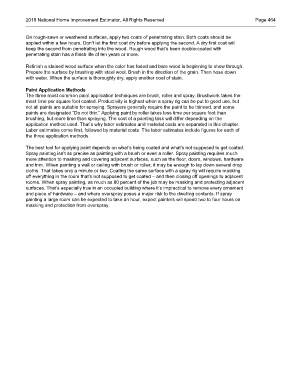Page 585 - 2018 National Home Improvement
P. 585
2018 National Home Improvement Estimator, All Rights Reserved Page 464
On rough-sawn or weathered surfaces, apply two coats of penetrating stain. Both coats should be
applied within a few hours. Don’t let the first coat dry before applying the second. A dry first coat will
keep the second from penetrating into the wood. Rough wood that’s been double-coated with
penetrating stain has a finish life of ten years or more.
Refinish a stained wood surface when the color has faded and bare wood is beginning to show through.
Prepare the surface by brushing with steel wool. Brush in the direction of the grain. Then hose down
with water. When the surface is thoroughly dry, apply another coat of stain.
Paint Application Methods
The three most common paint application techniques are brush, roller and spray. Brushwork takes the
most time per square foot coated. Productivity is highest when a spray rig can be put to good use, but
not all paints are suitable for spraying. Sprayers generally require the paint to be thinned, and some
paints are designated “Do not thin.” Applying paint by roller takes less time per square foot than
brushing, but more time than spraying. The cost of a painting task will differ depending on the
application method used. That’s why labor estimates and material costs are separated in this chapter.
Labor estimates come first, followed by material costs. The labor estimates include figures for each of
the three application methods.
The best tool for applying paint depends on what’s being coated and what’s not supposed to get coated.
Spray painting isn’t as precise as painting with a brush or even a roller. Spray painting requires much
more attention to masking and covering adjacent surfaces, such as the floor, doors, windows, hardware
and trim. When painting a wall or ceiling with brush or roller, it may be enough to lay down several drop
cloths. That takes only a minute or two. Coating the same surface with a spray rig will require masking
off everything in the room that’s not supposed to get coated – and then closing off openings to adjacent
rooms. When spray painting, as much as 80 percent of the job may be masking and protecting adjacent
surfaces. That’s especially true in an occupied building where it’s impractical to remove every ornament
and piece of hardware – and where overspray poses a major risk to the dwelling contents. If spray
painting a large room can be expected to take an hour, expect painters will spend two to four hours on
masking and protection from overspray.

